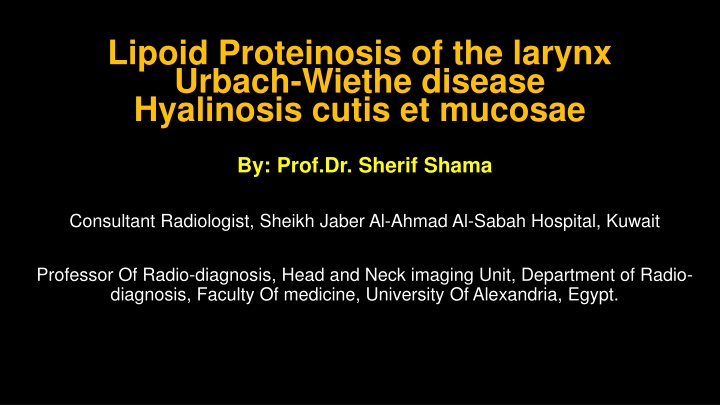
Lipoid Proteinosis of the Larynx: Case Study and Imaging Findings
This case study discusses a 13-year-old female patient presenting with stridor who underwent urgent tracheostomy due to a calcified laryngeal mass mimicking a neoplasm. CT scans revealed characteristic findings of Lipoid Proteinosis (Urbach-Wiethe disease) involving the larynx and brain. References to related studies are included.
Download Presentation

Please find below an Image/Link to download the presentation.
The content on the website is provided AS IS for your information and personal use only. It may not be sold, licensed, or shared on other websites without obtaining consent from the author. If you encounter any issues during the download, it is possible that the publisher has removed the file from their server.
You are allowed to download the files provided on this website for personal or commercial use, subject to the condition that they are used lawfully. All files are the property of their respective owners.
The content on the website is provided AS IS for your information and personal use only. It may not be sold, licensed, or shared on other websites without obtaining consent from the author.
E N D
Presentation Transcript
Lipoid Proteinosis of the larynx Urbach-Wiethe disease Hyalinosis cutis et mucosae By: Prof.Dr. Sherif Shama Consultant Radiologist, Sheikh Jaber Al-Ahmad Al-Sabah Hospital, Kuwait Professor Of Radio-diagnosis, Head and Neck imaging Unit, Department of Radio- diagnosis, Faculty Of medicine, University Of Alexandria, Egypt.
13 years old female patient presented with stridor and needed urgent tracheostomy Urgent CT showed calcified laryngeal mass lesion mimics laryngeal neoplasm. The mass was trans-glottic involving both aryepiglottic folds extends down to left true vocal cord with subglottic extension. No extra-laryngeal extension. Scans through the brain showed bilateral, symmetrical, horn-shaped (comma-shaped) calcifications within the medial temporal lobe of the brain affecting the amygdala. Carful history revision: she had history of Lipoid Proteinosis with characteristic skin lesions (Moniliform blepharosis) and Psychiatric features (absence of fear, hallucinations, delusions). Endoscopy and biopsy were performed and LP depositions were pathologically confirmed.
B A C CT scans for pathologically proven LP showing depositions within both aryepiglottic folds (arrows in A), calcified mass mimics laryngeal tumor (arrows in B, C), involvement of the left true vocal cord (arrow in D). The patient needed tracheostomy (E). E D
CT Scans through the brain showed bilateral, symmetrical, horn-shaped (comma-shaped) calcifications within the medial temporal lobe of the brain Characteristically affecting the amygdala (arrows).
References Staut CCV, Naidich TP. Urbach-Wiethe Disease(Lipoid Proteinosis). Pediatric Neurosurgery. 1998;28(4):212-214. doi:https://doi.org/10.1159/000028653 Parida JR, Misra DP, Agarwal V. Urbach-Wiethe syndrome. BMJ Case Reports. Published online September 2, 2015:bcr2015212443. doi:https://doi.org/10.1136/bcr-2015-212443. The case of SM, the fearless woman - Bytesize Science. YouTube. Published October 28, 2013. Accessed January 4, 2025. https://youtu.be/2Hi3JO1rqYw?si=ecRJBugkBt-aCgAz. Sharma R, Bell D, Knipe H, Urbach-Wiethe disease. Reference article, Radiopaedia.org (Accessed on 04 Jan 2025) https://doi.org/10.53347/rID-57147
